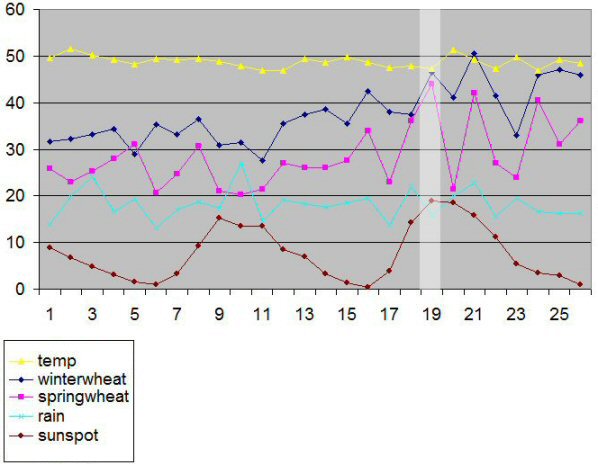Sunday, March 04, 2012
Ideas from an old book, 2
Following up on 'Ideas from an old book', where I found a tantalizing concept in Shepardson's 1901 book on electricity.
Questions: Do plants and trees get energy from ionization (electron transfer) along with sunlight? Is plant growth modulated directly by sunspots?
After some thought and googling, I settled on wheat yield (bushels/acre) instead of forest growth, because wheat is where the streetlight is. Richly documented and available.
Then decided to use Palouse wheat instead of Kansas wheat. The Palouse is closer to the Aurora, thus more likely to feel the Shepardson effect. Also avoids a couple of unwanted variables, because Palouse weather and farming practices are much more constant than Kansas. No prolonged droughts, no change from family to corporate ownership, no crop switches induced by subsidies. Just the same families working the same acres for a century, gradually improving their methods.
And I wanted to focus on the sunspot event of 1957, because it was the deepest penetration of the aurora over North America in living memory. If there's any effect, 1957 should bring it out.
I found exactly what I wanted in an old USDA document, PDF here. This shows winter and spring wheat yield for Whitman County from 1939 to 1964.
Added Palouse temperature and precip data from NCDC. (More detail in this entry.)
Tacked on a sunspot curve (PDF) from here.
Result is this chart with 1957 highlighted:

Corresponding Excel spreadsheet is here.
Not conclusive by any means, but 1957 certainly stands out, especially for spring wheat! The temperature wasn't doing anything special that year. Rain was up, but not nearly enough to spur the jump in yield.
Questions: Do plants and trees get energy from ionization (electron transfer) along with sunlight? Is plant growth modulated directly by sunspots?
After some thought and googling, I settled on wheat yield (bushels/acre) instead of forest growth, because wheat is where the streetlight is. Richly documented and available.
Then decided to use Palouse wheat instead of Kansas wheat. The Palouse is closer to the Aurora, thus more likely to feel the Shepardson effect. Also avoids a couple of unwanted variables, because Palouse weather and farming practices are much more constant than Kansas. No prolonged droughts, no change from family to corporate ownership, no crop switches induced by subsidies. Just the same families working the same acres for a century, gradually improving their methods.
And I wanted to focus on the sunspot event of 1957, because it was the deepest penetration of the aurora over North America in living memory. If there's any effect, 1957 should bring it out.
I found exactly what I wanted in an old USDA document, PDF here. This shows winter and spring wheat yield for Whitman County from 1939 to 1964.
Added Palouse temperature and precip data from NCDC. (More detail in this entry.)
Tacked on a sunspot curve (PDF) from here.
Result is this chart with 1957 highlighted:

Corresponding Excel spreadsheet is here.
Not conclusive by any means, but 1957 certainly stands out, especially for spring wheat! The temperature wasn't doing anything special that year. Rain was up, but not nearly enough to spur the jump in yield.
Labels: 20th century Dark Age, Carbon Cult
